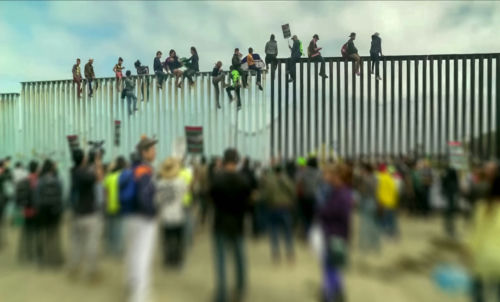President Trump’s latest border security move—painting the entire southern border wall black—signals a direct, visible challenge to illegal immigration and a clear rejection of past lax enforcement.
Trump Administration’s Black Border Wall: A Bold Deterrent Approach
On August 19, 2025, Homeland Security Secretary Kristi Noem stood before the press in Santa Teresa, New Mexico, unveiling President Trump’s latest border security directive: the entire southern border wall will be painted black. The administration’s stated intent is clear—make the wall so hot in the sun that it becomes a genuine physical barrier to illegal crossings. This move directly addresses conservative frustrations over years of porous borders and sends a powerful message that the era of open-door policies is over. Noem emphasized that the black coating not only deters illegal entry but also prolongs the wall’s lifespan by resisting rust, aligning operational effectiveness with fiscal responsibility.
Congress overwhelmingly backed this shift by passing the “One Big Beautiful Bill Act” in the summer of 2025, allocating a staggering $46 billion for wall completion and upgrades. The Trump administration wasted no time, with painting operations already underway in New Mexico and plans to extend across the entire border. This initiative is not a standalone gesture—it is part of a broader campaign that includes enhanced technology such as surveillance cameras, advanced sensors, and increased patrols. The scale of the effort reflects an administration determined to fulfill its promises of restoring border integrity, prioritizing American sovereignty, and rejecting the globalist trends that defined the previous administration.
Background: From Campaign Promise to National Policy
The border wall has long been a flashpoint in American politics, symbolizing the broader debate about national security, immigration, and constitutional order. Trump’s first term saw significant progress stymied by legal challenges and congressional resistance, yet the vision endured. The concept of painting the wall black to amplify its deterrent value was first floated in 2020, but only now, with conservative majorities and resolute executive leadership, is it being fully realized. The black wall stands not just as a physical barrier, but as a rebuke to years of what many view as failed, politically motivated border policies that enabled lawlessness and overburdened American communities.
Key stakeholders driving this transformation include President Trump himself, who set the policy direction; Secretary Noem, who is spearheading implementation; the Department of Homeland Security, which oversees the project; and the U.S. Border Patrol, tasked with daily enforcement. Congressional backing—particularly from Trump-aligned lawmakers—has unlocked the resources necessary to move beyond incremental changes and toward systemic reform. The administration’s strategy is to combine physical deterrence with technological advancement, maximizing the wall’s effectiveness while minimizing avenues for illegal entry.
Impacts: Deterrence, Debate, and the Future of Border Security
Supporters argue this policy is a common-sense, cost-effective way to enhance border security, deter illegal crossings, and protect taxpayer investment by extending the wall’s durability. They view the initiative as restoring constitutional order, ensuring that U.S. law is respected, and reinforcing the nation’s right to control its borders. However, critics—primarily from activist groups and left-leaning media—question the deterrent effects and raise concerns about humanitarian impacts, particularly for migrants exposed to extreme heat. Expert assessments vary: while some security professionals acknowledge the deterrent potential, others note that determined crossers may still find ways around physical obstacles. Nonetheless, the administration’s focus is on operational results and the message sent to would-be border violators: America will no longer tolerate lawlessness or disregard for its sovereignty.
The larger implications are significant. Border communities stand to see reduced illegal crossings and increased safety, while taxpayers are assured that federal funds are being deployed for concrete, measurable results. Politically, this move galvanizes the administration’s base, offering a stark contrast to the previous era’s policies that many conservatives saw as undermining both the Constitution and national security. With the black border wall as its emblem, the Trump administration is reasserting American values, defending the rule of law, and putting the interests of citizens first—an approach that resonates deeply with a conservative audience tired of government overreach and failed progressive experiments.
While debate over the wall’s long-term effectiveness will continue, there is no question that this highly visible policy signals a new era: one where border security takes precedence over political correctness, and where constitutional protections and fiscal prudence are restored. The Trump administration’s actions mark a decisive break from the past, offering both a practical deterrent and a powerful symbol of renewed national resolve.
Sources:
Trump border wall gets black paint job in new deterrent push (Axios)
Kristi Noem reveals striking new layer in Trump’s border wall strategy (Fox News)

